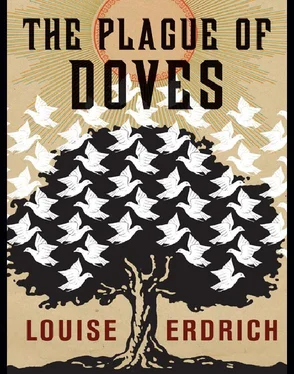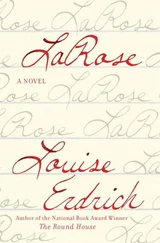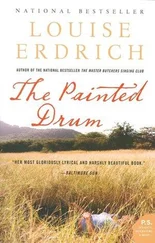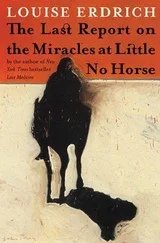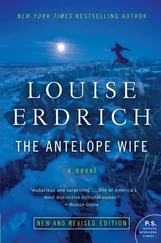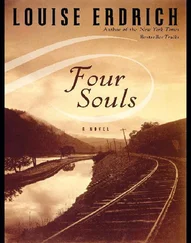Louise Erdrich
The Plague of Doves
The gun jammed on the last shot and the baby stood holding the crib rail, eyes wild, bawling. The man sat down in an upholstered chair and began taking his gun apart to see why it wouldn’t fire. The baby’s crying set him on edge. He put down the gun and looked around for a hammer, but saw the gramophone. He walked over to it. There was already a record on the spindle, so he cranked the mechanism and set down the needle. He sat back down in the chair and picked up his work as the music flowed into the room. The baby quieted. An unearthly violin solo in the middle of the record made the man stop, the pieces of the gun in his hands. He got up when the music was finished and cranked the gramophone and put the recording back on. This happened three times. The baby fell asleep. The man repaired the gun so the bullet slid nicely into its chamber. He tried it several times, then rose and stood over the crib. The violin reached a crescendo of strange sweetness. He raised the gun. The odor of raw blood was all around him in the closed room.
IN THE YEAR 1896, my great-uncle, one of the first Catholic priests of aboriginal blood, put the call out to his parishioners that they should gather at Saint Joseph’s wearing scapulars and holding missals. From that place they would proceed to walk the fields in a long, sweeping row, and with each step loudly pray away the doves. His human flock had taken up the plow and farmed among German and Norwegian settlers. Those people, unlike the French who mingled with my ancestors, took little interest in the women native to the land and did not intermarry. In fact, the Norwegians disregarded everybody but themselves and were quite clannish. But the doves ate their crops the same.
When the birds descended, both Indians and whites set up great bonfires and tried driving them into nets. The doves ate the wheat seedlings and the rye and started on the corn. They ate the sprouts of new flowers and the buds of apples and the tough leaves of oak trees and even last year’s chaff. The doves were plump, and delicious smoked, but one could wring the necks of hundreds or thousands and effect no visible diminishment of their number. The pole-and-mud houses of the mixed-bloods and the bark huts of the blanket Indians were crushed by the weight of the birds. They were roasted, burnt, baked up in pies, stewed, salted down in barrels, or clubbed dead with sticks and left to rot. But the dead only fed the living and each morning when the people woke it was to the scraping and beating of wings, the murmurous susurration, the awful cooing babble, and the sight, to those who still possessed intact windows, of the curious and gentle faces of those creatures.
My great-uncle had hastily constructed crisscrossed racks of sticks to protect the glass in what, with grand intent, was called the rectory. In a corner of that one-room cabin, his younger brother, whom he had saved from a life of excessive freedom, slept on a pallet of fir boughs and a mattress stuffed with grass. This was the softest bed he’d ever lain in and the boy did not want to leave it, but my great-uncle thrust choirboy vestments at him and told him to polish up the candelabra that he would bear in the procession.
This boy was to become my mother’s father, my Mooshum. Seraph Milk was his given name, and since he lived to be over one hundred, I was present and about eleven years old during the time he told and retold the story of the most momentous day of his life, which began with this attempt to vanquish the plague of doves. He sat on a hard chair, between our first television and the small alcove of bookshelves set into the wall of our government-owned house on the Bureau of Indian Affairs reservation tract. Mooshum would tell us he could hear the scratching of the doves’ feet as they climbed all over the screens of sticks that his brother had made. He dreaded the trip to the outhouse, where many of the birds had gotten mired in the filth beneath the hole and set up a screeching clamor of despair that drew their kind to throw themselves against the hut in rescue attempts. Yet he did not dare relieve himself anywhere else. So through flurries of wings, shuffling so as not to step on their feet or backs, he made his way to the outhouse and completed his necessary actions with his eyes shut. Leaving, he tied the door closed so that no other doves would be trapped.
The outhouse drama, always the first in the momentous day, was filled with the sort of detail that my brother and I found interesting. The outhouse, well-known to us although we now had plumbing, and the horror of the birds’ death by excrement, as well as other features of the story’s beginning, gripped our attention. Mooshum was our favorite indoor entertainment, next to the television. But our father had removed the television’s knobs and hidden them. Although we made constant efforts, we never found the knobs and came to believe that he carried them upon his person at all times. So we listened to our Mooshum instead. While he talked, we sat on kitchen chairs and twisted our hair. Our mother had given him a red coffee can for spitting snoose. He wore soft, worn, green Sears work clothes, a pair of battered brown lace-up boots, and a twill cap, even in the house. His eyes shone from slits cut deep into his face. The upper half of his left ear was missing, giving him a lopsided look. He was hunched and dried out, with random wisps of white hair down his ears and neck. From time to time, as he spoke, we glimpsed the murky scraggle of his teeth. Still, such was his conviction in the telling of this story that it wasn’t hard at all to imagine him at twelve.
His big brother put on his vestments, the best he had, hand-me-downs from a Minneapolis parish. As real incense was impossible to obtain, he prepared the censer by stuffing it with dry sage rolled up in balls. There was an iron hand pump and a sink in the cabin, and Mooshum’s brother, or half brother, Father Severine Milk, wet a comb and slicked back his hair and then his little brother’s hair. The church was a large cabin just across the yard, and wagons had been pulling up for the last hour or so. Now the people were in the church and the yard was full of the parked wagons, each with a dog or two tied in the box to keep the birds and their droppings off the piled hay where people would sit. The constant movement of the birds made some of the horses skittish. Many wore blinders and were further calmed by the bouquets of chamomile tied in their harnesses. As our Mooshum walked across the yard, he saw that the roof of the church was covered with birds who constantly, in play it seemed, flew up and knocked a bird off the holy cross that marked the cabin as a church, then took its place, only to be knocked off the crosspiece in turn. Great-uncle was a gaunt and timid man of more than six feet whose fretful voice carried over the confusion of sounds as he tried to organize his parishioners. The two brothers stood in the center of the line, and with the faithful congregants spread out on either side they made their way slowly down the hill toward the first of the fields they hoped to clear.
The sun was dull that day, thickly clouded over, and the air was oppressively still so that pungent clouds of sage smoke hung all around the metal basket on its chain as it swung to each direction. The people advanced quickly. However, in the first field the doves were packed so thickly on the ground that there was a sudden agitation among the women, who could not move forward without sweeping birds into their skirts. The birds in panic tangled themselves in the cloth.
Читать дальше
